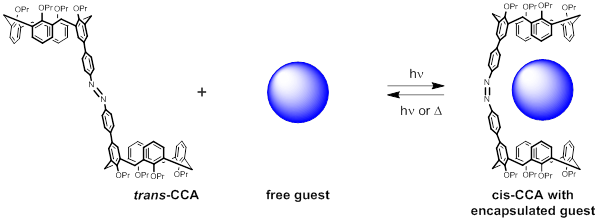58th Annual Report on Research 2013 Under Sponsorship of the ACS Petroleum Research Fund
Reports: UR451689-UR4: Exploring the Controllable Uptake and Release of Pyridinium Ions with a Photoactive Calixarene-Capped Azobenzene
Paul A. Bonvallet, PhD, College of Wooster
I. Technical progress. Our efforts in this first year have focused on screening various pyridinium-, ammonium-, and diimidazolium-derived guest compounds for their reversible encapsulation and release from calixarene-capped azobenzene (CCA) host. The function of this host container comes from the trans-cis photoisomerization reaction of azobenzene, whereby two geometrically distinct “open” and “closed” forms can be produced in response to light.
Guests: (counterions primarily I- or PF6-)
We have determined by 1H NMR spectroscopy that a range of mono- and dications bind weakly with trans-CCA (which is desirable, given the need for the guest to be released from the open container). However, there appears to be little difference in the NMR spectra of these guests when CCA is converted into the cis (closed) form. This result implies that either (1) the guest is too small and unable to bind with both hemispheres of CCA, or (2) the two hemispheres of CCA in the cis configuration are not aligned in such a way that they do not converge upon the central guest.
The non-polar nature of the host and the polarity of the guests has limited the range of solvents suitable for dissolving both molecular components. We are addressing this challenge by (1) investigating a range of different counterions for each guest, and (2) synthesizing a functionalized analog of CCA that includes solubility-enhancing groups along the lower rims of each calixarene hemisphere.
Additionally, we have discovered that photoirradiation with an array of UV-emitting LEDs provides superior trans-to-cis conversion of CCA (80%) compared to long-wave UV (35%) or a filtered arc lamp (65%). We also have carried out numerous kinetics experiments for the cis to trans reversion of CCA (in the absence of any guests) and found that Cu2+ ion accelerates this reaction. An investigation of the mode and mechanism of this rate acceleration is underway.
II. Impact on undergraduate development. Two students were directly supported by this grant in their summer research projects. Mary Nappi graduated with a chemistry degree in May 2013 and recently started in the chemistry Ph.D. program at The Ohio State University. Virginia Iungerich just started her junior year at the College of Wooster. Andrea Steiger, a senior, has worked on the synthesis and kinetics aspects of this project with the support of the Clare Boothe Luce Foundation. She presented her work at the spring national ACS meeting in New Orleans in 2013. Lucy Moser, who recently graduated with a chemistry degree, examined some of the host-guest binding as part of her yearlong Senior Independent Study research project. Lucy delivered a poster presentation of her work during Wooster's day-long Senior Research Symposium.
The support of PRF has enabled this group of students to develop their skills in project management, multitasking, and written and oral communication. We hold regular group meetings among all members of the synthetic chemistry community during the summer so that students can share their results with faculty and peers. Most importantly, they are learning how to “think like a scientist” by describing their work to others, overcoming practical and technical challenges, collecting and interpreting data, and supporting their claims with evidence.
III. Impact on PI development. A multi-year grant helps to establish a continuous and self-sustaining research program in one focused area. The PI has deliberately built a community of researchers, both during the summers and the academic year, involving students of varying levels of experience. This critical mass of undergraduates in the research laboratory helps to build a culture of collaboration, expertise, and professional service in which the experienced students can assist in training the newer ones.
The PI has made this project a primary focus in Senior Independent Study, Wooster's yearlong self-designed research program undertaken by every senior. The research was featured in a presentation at the national ACS meeting in New Orleans in 2013 as well as in invited research seminars at SUNY-Cortland and Ithaca College.
Copyright © 2014 American Chemical Society













